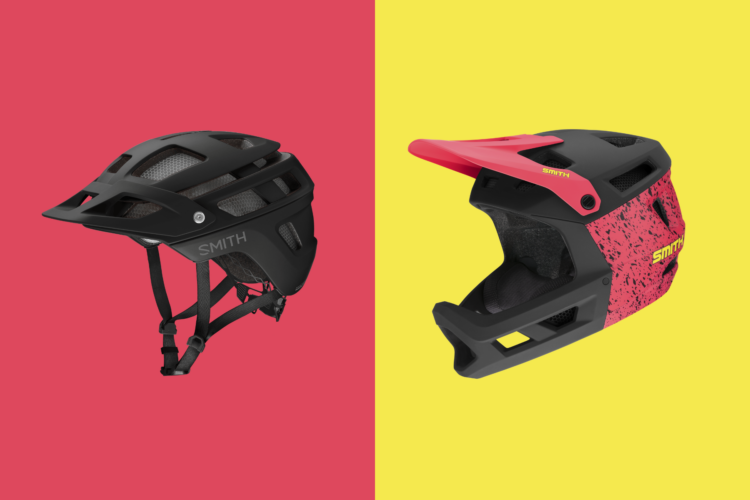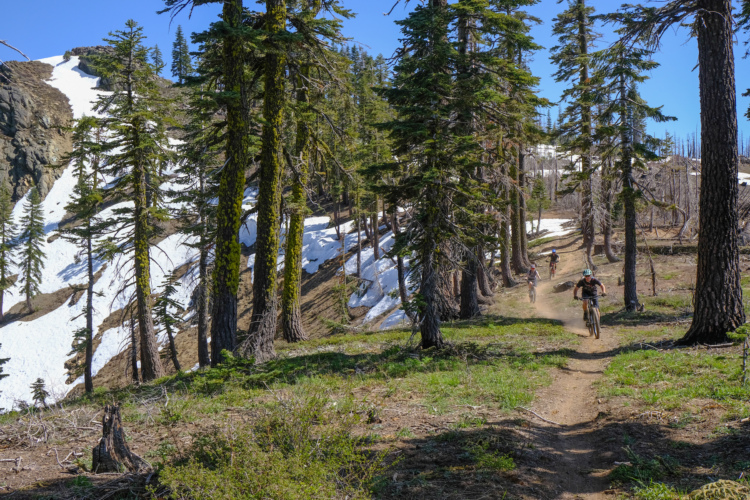
All indications are that shuttling occupies a coveted place in mountain bike land, and that’s not likely to change any time soon. Look at any list of top mountain bike trails and you’ll find a good chunk of them are generally considered to be shuttle rides. A few of the top 20 rides here on Singletracks, including the overall #1, The Whole Enchilada, are dedicated shuttles, and more are often done as optional shuttles. At the same time, shuttlers catch a lot of heat from “real” mountain bikers who see no valid reason to include more motor vehicle time for what should be a human-powered activity. Reasons to shuttle, or to eschew shuttling, vary from rider to rider based on a wide variety of criteria, including fitness, riding style, objectives for the ride, and the nature of the ride itself.
Reasons to Shuttle
Avoid the climb

If we’re all honest with ourselves, the reason most of us shuttle is usually to skip the vegetables and go straight for dessert. A long climb may be great for fitness, good for building character, or a unique sort of meditation for cleansing the soul. However, few of us actually think of climbing as “fun,” and in general, mountain biking is supposed to be fun. Who doesn’t want to go straight for the cheesecake or apple pie once in a while?
[see_also id=’177365′]
Get more reps
I’ll never forget one arrival at the top of the South Canon Trails near Canon City, Colorado, a favorite riding spot. As I gathered my breath for the downhill, a pickup truck pulled into the upper trailhead and a few cyclists hopped out and unloaded their bikes. One of the rirders was occasional riding buddy and Singletracks contributor Vitaly, who was not only a couple decades younger than I, but was probably fitter than I was a couple decades ago.
At just 1,100 vertical feet, the climb wasn’t overly onerous, and a reasonably fit rider could do it with little difficulty. Why the heck was he shuttling? He simply responded that he and his riding buds could get more laps, more miles, and more importantly, more fun miles by shuttling. Even for the fittest rider, long climbs take time; time which could be spent shredding rather than grunting. If a fit young rider like Vitaly can justify shuttling, then anybody can, especially if the goal of the ride is to maximize fun time. A shuttle can serve the same purpose as a chairlift in places that don’t have chairlifts.
Distance

Some shuttles don’t involve huge vertical relief, but the sheer distance involved makes them hugely challenging, if not dangerous or even deadly, without a shuttle. Consider a couple of Moab’s classics, the Whole Enchilada or the Mag 7. While elevation change alone would prevent all but riders with world-class fitness from looping The Whole Enchilada, the elevation difference on the Mag 7 is rather small. But the route is long and rugged, and after 22 miles of challenging, rugged, exposed, up and down trail, pedaling that far again in the desert heat to close the loop isn’t an option for most people. Extreme long distance routes lend themselves to this sort of “point-to-point” shuttle rather than a “downhill shuttle.” The McKenzie River trail in Oregon is another famous example.
Because it’s a shuttle ride!
Some shuttles are shuttles just because that’s what they’ve become, or that’s what’s required. Many trails that make rippin’ good downhills are simply not climbable in the saddle, so shuttle you must. Some trails are simply one way trails, either by official regulation or unwritten local edict, and there’s no viable cycling route to close the loop. But for most de facto shuttle runs, there are alternatives, but few, if any mountain bikers find the options palatable.
It is certainly possible to make the 4,000 vertical foot climb from Poncha Springs to the top of Monarch Pass to make a loop out of the famed Monarch Crest route. But beyond the crushing vertical itself, it’s all on a busy, paved highway, which hardly an ingredient in a great mountain bike ride. There are a few hardy souls who loop the Crest, but they are rare and, let’s be honest here, not at all normal human beings.
[see_also id=’64193′]
Reasons not to shuttle
Because it’s cheating!

Since shuttling is such an enabler for those looking to either explore many miles of backcountry trail, or just to maximize pleasure time, why would anyone not shuttle? In a word: it’s cheating. Shuttling is anathema to to purists who see it as an assault on the integrity of the sport, or simply as a crutch for the weak, lame, or lazy. Ever wonder what the better-than-yous used to complain about before the scourge of e-bikes? You guessed it: shuttle monkey/shuttlecocks, or any other other pejorative term they could come up with for people who didn’t “earn their el.”
Extend the ride
Sometimes, maximizing saddle time is more important than isolating the fun part of the ride. This is especially true on a trail that offers a different, but rideable experience, in both directions, making it a good candidate for an out-and-back. The same goes for shuttlable rides that have a good singletrack loop option. Even without a singletrack option, a paved option to close the loop can be a great part of a long ride if the pavement passes through a nice environment with good scenery. The long climb up the pavement to the top of Grand Junction’s Ribbon Trail above the famed Lunch Loops makes for a nice spin through high desert/pinion and juniper forest.

Fitness
The most obvious reason to skip the shuttle is simply to get more exercise. This reason stands independent of whether or not the rest of the loop is in desirable territory. This is for training purposes, pure and simple. Since the riders who do this are generally more interested in the work than the fun in the first place, this option appears far more often in cross-country, point-to-point type shuttle rides than on downhill shuttles.
There’s no shuttle available
Sometimes, biting the bullet and hitting the climb is simply done out of necessity. It’s not because the rider is a purist looking to maintain the integrity of the sport, or a hardcore hammerhead looking to train hardy, but simply because there is no other option for riding that particular trail at that particular time.
Ways to shuttle
Commercial shuttle service
Most of the marquee shuttle rides will have commercial options where bike and rider can catch a hop to the top. Most are surprisingly well-priced and offer genuinely good value in terms of fun bang for your shuttle buck. Such shuttles exist for both epic rides that a single run will occupy a full day like the aforementioned Monarch Crest or Whole Enchilada, or shuttles that offer multiple laps on shorter runs, like Nevada’s Bootleg Canyon or Idaho’s Jug Mountain Ranch.

Grab your buds and go….
Many traditionally shuttled runs, like Colorado Springs’ Jones Park, have never had commercial shuttle service, so a private shuttle is the only way to go. It’s nice to have multiple friends with vehicles capable of hauling multiple bikes at a time. Even better is to have a non-riding buddy who doesn’t mind dropping you off at the top from time to time.
The power of the thumb
While I don’t recommend bike-hitchhiking for obvious reasons, especially in the modern world, I have at times accepted an offer from a friendly passerby in a pickup who saw me struggling up a long grade. Parts of my home state of Colorado actually have a long history of this with regard to backcountry skiing as open thumbs will line the base of certain mountain passes to get run after run in untracked powder far from the maddening crowds of the state’s overpacked resorts. So it only seems a natural extension that knobby riders would start doing the same with their bikes.
In the end, the decision to shuttle, and what one wants to get out of the shuttle, is as personal as the reasons we ride bikes in the first place. The validity of doing so is strictly in the mind of the beholder, and we should all go ride and have fun, guilt-free. As an older rider whose limitations have been compounded by as yet, medically undiagnosable fatigue issues, I am far more open to shuttling than I used to be …
… but personally, I’m still not ready to self-shuttle with an e-bike!



















10 Comments
Jul 18, 2018
- route is impractical/dangerous to ride as a loop (Monarch Crest, McKenzie River, Whole Enchilada type rides)
Unacceptable reasons to shuttle:
- climbing is hard (Devils Gulch, Alpine/ATCA, the majority of Cogwild and Oregon Adventures runs)
- to get more runs in on climbable routes - especially when they're multi-use and have two-way traffic.
Jul 19, 2018
Jul 16, 2018
Jul 16, 2018
Jul 16, 2018
I ride in “k” country near CALGARY. Moose Mountain is A ride I do but have never shuttled it. At 55yrs old I sometimes think I should but half the ride for me is the uphill challenge and it is a challenge when you include Braggin Rights and Ranger Summit on the same ride. There are many people a lot young that scuttle MM because they are DH riders. Good for them. Are they hurting anyone, no. Each to their own. People should stop being judgemental and just enjoy what they like doing best. Ride on...!
Jul 16, 2018
Starting down being dead tired could lead to getting injured. I would say that shuttles are worth there weight in gold!
Jul 19, 2018
Jul 21, 2018
Jul 19, 2018
Dec 6, 2022